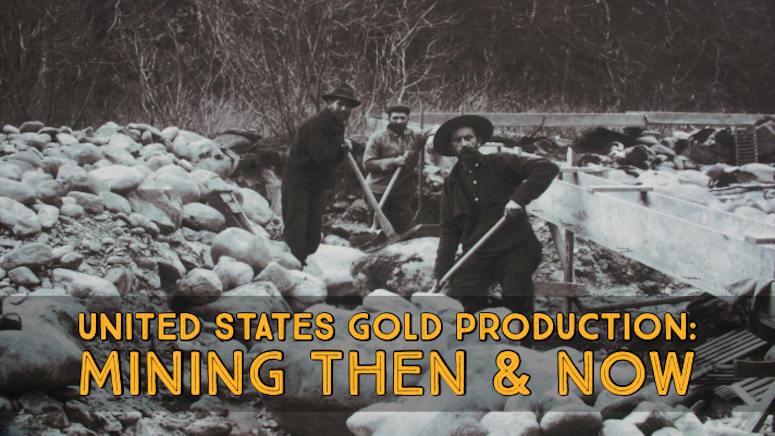
A History of Mining in the USA
The first documented gold discovery in the United States was in 1799. Since that time, there have been thousands of new gold strikes, prompting men and women from around the world to come to America in search of gold.
With a few exceptions, the richest gold mining has always been in the West. Most notable were the gold discoveries of the California Mother Lode. This was responsible for one of the largest migrations of people in modern history.
Other major strikes were soon to follow. The Black Hills of South Dakota, the Pike’s Peak Rush in Colorado, and the Klondike Rush to Alaska. There would be many more to follow, and each would cause excitement that would spread across the country. Some panned out, while others ended almost as quickly as they started.
The Major Gold Producing States – The First 150 Years
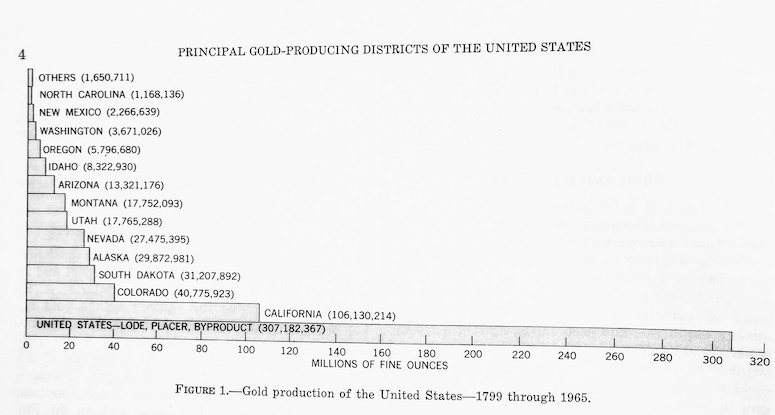
This graph gives us an overview of the gold production in the United States from 1799 (the date of the first gold discovery in the USA) through 1965.
The mid-to-late 1800s were an exciting time for hopeful gold prospectors in the United States. Although a few early gold strikes in North Carolina and Alabama had certainly garnered much interest at the time, it was the strikes on the American River in California that changed everything.
Suddenly, the West appeared to have limitless potential. It seemed that new gold discoveries were being made all the time. Prospectors ventured out and found gold in Oregon, Nevada, Idaho and New Mexico. Within a few years, gold was being mined in every state in the West, up into Canada. Men wen would eventually make it into the wilderness of Alaska and strike gold at the Klondike.
Placer deposits found in creeks and rivers were the first to be mined. Some were exceedingly rich, but they played out fast. Usually the best placer claims were considered “worked out” within a year or two. Once the easy gold was found, miners would either move on to richer ground or try and find the lode.
Locating hard rock gold was difficult, but was still only part of the process. Once a promising vein of gold was located the real work began. Tunneling into the Earth to extract and process gold ore takes investment and lots of it. This was no job for the individual prospector. It took the resources of large mining companies to develop a hard rock mine.
Read: Unexpected & Overlooked Places You Can Discover Gold
Historically Rich Gold Mining Districts
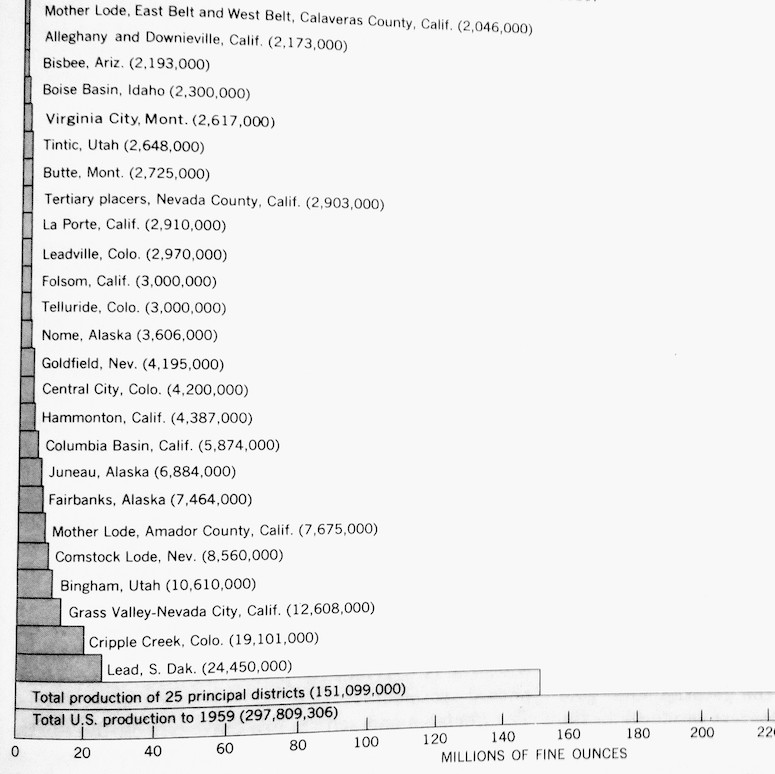
This chart shows more detail showing 25 mining districts that produced the most gold from 1799 through 1959. These numbers are rough estimates at best, but they give us a general idea of where most of the gold has been historically mined.
The early placer miners would use hydraulic monitors to blast away at ancient rivers channels that contained the gold. These mines produced a lot of gold, and were responsible for a great amount of the production indicated in the graphs above.
Hydraulic mining worked on bench deposits and ancient placers, but gold veins in the rock required tunneling underground. This was a considerable undertaking and many mines took years to establish.
Boomtowns would come and go. Most mining districts would sustain a population for a few years. The major ones would last for a few decades. Very rarely did a town last for much longer; once the ore was gone it was time to move on.
After the initial gold rushes that mostly took place in a span from 1849 through 1899, the number of men employed as miners dropped substantially. There were mines in operation, but there were few discoveries being made by the turn of the 20th century, and the excitement was mostly over.
The widespread use of bucket-line dredges in the early to mid-1900s substantially increased the gold production in the United States. Primarily due to the sheer volume of gravels that they processed, the amount of gold recovery was substantial.
Read: Prospecting for Gold Ore – Techniques to find Rocks with Gold
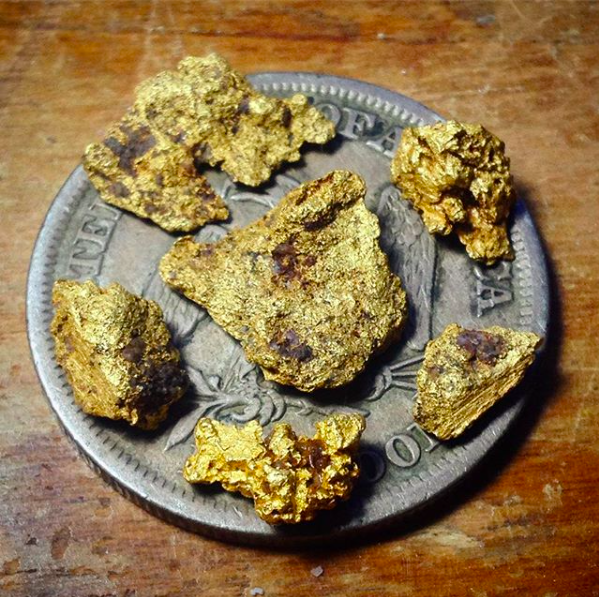
Huge Changes in the Last 50 Years:
The charts above give a good representation of historic gold production in the US. Those come from a report titled “Principle Gold-Producing Districts of the United States”. This information is very valuable for a modern prospector who is looking for the best places to mine for gold, but it should be noted that there have been some changes to since the report was published in 1968.
Below are a few noteworthy occurrences that have changed the landscape of mining in the United States over the past 50 years.
Despite being one of the richest gold-bearing states, large-scale mining has become almost non-existent in this once golden state. Environmental regulations have placed limits on even the smallest mining activities Suction dredging was the primary way to recover placer gold from the rivers and streams is now illegal in California. Large mines face big hurdles as well, and the big companies generally avoid California all together to focus their efforts on more “miner friendly” places.
Lead, South Dakota was the single richest gold mining area in the USA at one time. The Homestake Mine was the biggest producer. It produced over 40-million ounces of gold from low-grade ores during its production. However, the mine closed in 2001 due to high production costs and low gold prices. This dropped South Dakota out of the top spot.
Nevada has always been a mineral rich state, but it was the Carlin Deposits found in Northern Nevada that completely changed mining in the USA. Because these ores were so low-grade, they were completely missed by prospectors and geologists until the 1960s. This became the richest gold region in the country, and because of it, the state of Nevada now ranks #1 for both gold and silver production.
Utah’s ranking as a gold producer is almost entirely dependent on the Bingham Copper Mine. It is the largest man-made excavation on Earth and produces nearly 20% of the copper needs of the United States. Gold is merely a by-product at this mine, but with over 400,000 tons of material removed from the mine each day, the gold recovered is substantial.

This country once has thousands of active, underground mining operations following rich veins of silver and gold throughout the West. There are still some mines left working today, but most have been forgotten. The reason wasn’t always because the gold ran out. Many of them were abandoned after World War 2. After the war, they were in such disrepair that it was not economically feasible to reopen them.
In the mid-1900s, the richest placer districts in the country were being churned up by bucket line dredges. These monster machines would process huge amounts of river gravel and recovered tons of gold through the West. They worked amazingly well, but their impact on the environment because a concern, and many of them were dismantled in the 50s and 60s. There are almost no active ones left in operation, and the placer gold production has plummeted as a result.
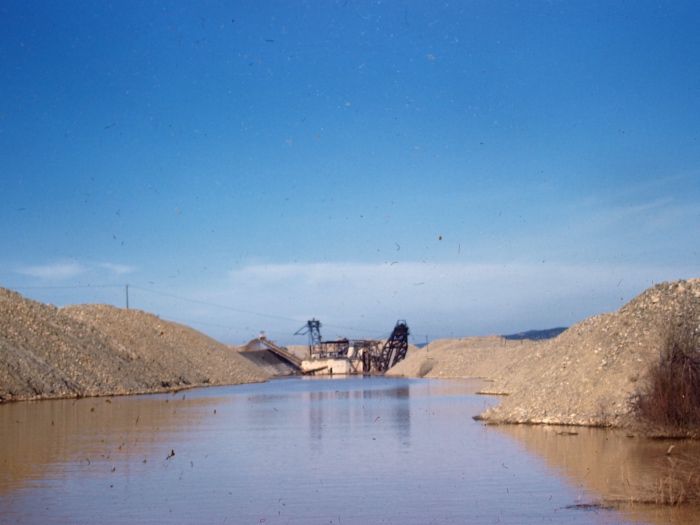
Today’s Mining Industry in the USA
The days of hydraulic mining and extensive bucket dredging are long gone. In fact, mining in the United States has changed a great deal over the past 50 years.
Most notably is the shift away from the small-scale miner. In our modern era of environmental regulation, it is quite difficult for the average person to get a mine established in most of the US today. Nearly all of the appreciable gold production today is being done by a relatively select group of large mining companies.
Open-pit mining operations are producing the majority of the gold in the United States. These huge mines process hundreds of tons of ore per day.
Next: Top 10 States for Serious Gold Miners







